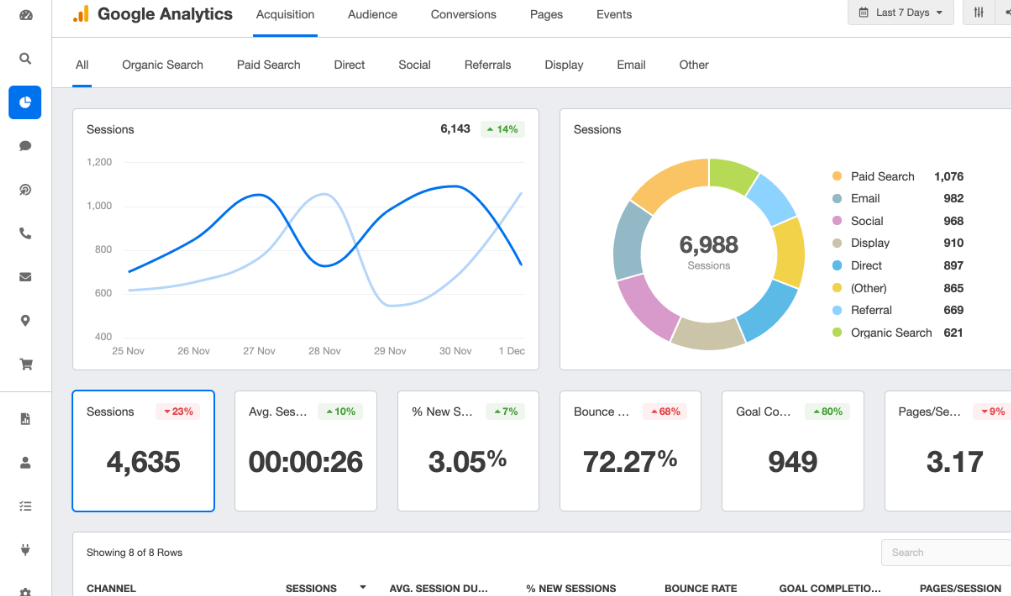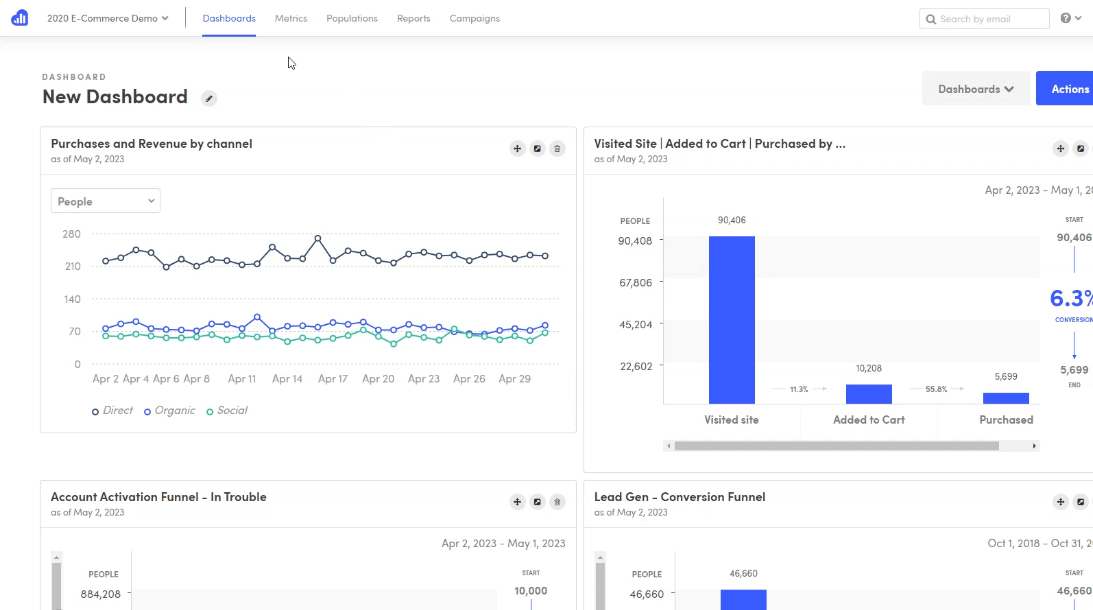Are you struggling to understand your customers’ behaviors and how they interact with your business? A study shows that effective customer behavior analysis can significantly improve marketing strategies and boost customer engagement.
In this comprehensive guide, we will walk you through the process of conducting an in-depth customer behavior analysis, from defining objectives to identifying key insights.
Key Takeaways
- Customer behavior analysis is the process of studying how customers behave, make decisions, and interact with a business.
- It helps businesses tailor their marketing strategies, improve customer engagement, increase conversions, and achieve their goals.
- Conducting a customer behavior analysis involves defining objectives, collecting relevant data, segmenting the customer base, analyzing behavior patterns, creating customer personas, and identifying key insights.
- Tools like Google Analytics, Hotjar, Mixpanel, Kissmetrics,and Salesforce Customer 360 can help in conducting effective customer behavior analysis.
What is Customer Behavior Analysis?

Customer Behavior Analysis refers to the process of studying and understanding how customers behave, make decisions, and interact with a business. It involves analyzing data and patterns to gain insights into consumer preferences, motivations, and buying habits.
By understanding customer behavior, businesses can tailor their marketing strategies, improve customer engagement, increase conversions, and ultimately achieve their business goals.
Definition
Customer behavior analysis is a deep look at how buyers act with your firm. It uses both number data and people’s views to dig into customer actions. This study lets companies see how customers use their goods, services, and brand name.
Businesses split their audience into groups in this process. They find out why each bunch likes the company’s offers. Then they can plan their sales ideas around this info.
Companies can march ahead of rivals by studying consumer actions well. They may get tips that make customers join in more fully. They learn about shopping habits and reactions to sales plans too.
With all these details, businesses know their audience better and meet their needs well.
Benefits for Business Success
Knowing your customers can make a big change in your business. You can use customer behavior analysis to learn about your clients. This info helps you plan better marketing efforts.
It also lets you meet the needs of each client.
With this tool, businesses can find out how often their customers buy things. They can see if clients react well to their ads or not. All this data is very helpful for companies that want to do better and grow bigger.
Over time, this understanding leads to more sales and happier customers!
How to Conduct a Customer Behavior Analysis

To conduct a customer behavior analysis, start by defining your objectives and collecting relevant data. Then, segment your customer base to better understand their behavior patterns.
Next, create customer personas to gain deeper insights into their preferences and motivations. Finally, identify key insights that will inform your marketing strategies and help you acquire and retain customers effectively.
Define Objectives
To start, you need clear goals. Ask what you want to learn from the customer behavior analysis. Do you want to find out why people buy your products? Maybe you are keen on knowing which ads work the best.
Clear objectives guide what data to collect and help track progress. This is how businesses make smart plans for their customers’ needs.
Collect Relevant Data
To conduct a customer behavior analysis, it is important to collect relevant data. This data will provide valuable insights into how customers interact with your company and its products or services.
You can gather this information through various methods, such as surveys, interviews, website analytics, and social media monitoring. By analyzing the collected data, you can identify patterns and trends in customer behavior that will help you make informed decisions about your marketing strategies.
Remember that collecting accurate and up-to-date data is crucial for obtaining meaningful insights into customer behavior.
Segment Customer Base
Segmenting your customer base is a crucial step in analyzing customer behavior. By dividing your customers into distinct groups based on their characteristics, preferences, and behaviors, you can gain valuable insights into how to effectively target and engage with each segment.
This allows you to tailor your marketing strategies and communication efforts to meet the specific needs of different customer groups. For example, if you discover that a certain segment consists mostly of young professionals who prefer mobile shopping, you can focus on optimizing your mobile app or website for an enhanced user experience.
By understanding the unique benefits each segment derives from your products or services, you can create personalized marketing messages that resonate with them and drive conversions.
Analyze Behavior Patterns
Analyzing behavior patterns is a crucial step in customer behavior analysis. By examining how customers interact with your products, services, and brand, you can gain valuable insights into their preferences and needs.
This analysis helps businesses understand how often customers make purchases and how they respond to marketing campaigns. By identifying these patterns, businesses can tailor their strategies to better meet customer expectations and boost engagement.
It also allows companies to improve their understanding of their target audience, making informed decisions and optimizing marketing efforts accordingly.
Create Customer Personas
Creating customer personas is a crucial step in conducting a customer behavior analysis. Customer personas are detailed profiles that represent different segments of your target audience.
These profiles help you understand the needs, preferences, and behaviors of your customers.
To create customer personas, you need to gather data about your customers through surveys, interviews, and analyzing their interactions with your website or app. Look for patterns and common characteristics among your customers to identify distinct groups.
This could include demographics like age, gender, and location, as well as psychographic factors such as interests and values.
Once you have identified these segments, give each persona a name and describe their characteristics in detail. This may include information about their goals, challenges, motivations, preferred communication channels, and buying habits.
By understanding these personas better, it becomes easier to customize marketing messages and tailor products or services to meet their specific needs.
Identify Key Insights
Customer behavior analysis allows businesses to identify key insights about their customers. By analyzing how customers engage with their products and services, businesses can gain valuable information about customer preferences, purchasing patterns, and motivations.
These insights help in understanding what drives customer satisfaction and loyalty, as well as identifying pain points or areas for improvement. With this knowledge, businesses can make informed decisions to optimize their marketing strategies and tailor their offerings to meet the needs of their target audience.
The use of tools like Google Analytics, Hotjar, Mixpanel, Kissmetrics, and Salesforce Customer 360 can further aid in gathering data and extracting meaningful insights from customer behavior analysis.
Tools for Conducting Customer Behavior Analysis
Some of the top tools for conducting customer behavior analysis include Google Analytics, Hotjar, Mixpanel, Kissmetrics, and Salesforce Customer 360.
Google Analytics
Google Analytics is a popular tool for conducting customer behavior analysis. It provides valuable insights into how customers interact with your website and online campaigns. With Google Analytics, you can track important metrics like page views, bounce rate, and conversion rates.
You can also segment your audience based on demographics and analyze their behavior patterns. This information can help you personalize the customer experience, identify pain points, and make accurate predictions about customer preferences.
By using Google Analytics, businesses can optimize their marketing strategies to acquire and retain customers effectively.

Hotjar
Hotjar is a powerful tool that businesses can use to conduct customer behavior analysis. It provides valuable insights into how users interact with a website or app, helping companies understand what drives their customers’ behaviors.
With Hotjar, businesses can track and analyze user sessions, heatmaps, click maps, and conversion funnels. This data helps them identify areas where users might be experiencing difficulties or dropping off in the conversion process.
By understanding these pain points, businesses can make informed decisions on how to improve their website or app design and enhance the overall customer experience. Hotjar also offers features like feedback polls and surveys that allow companies to directly gather input from their customers.
Mixpanel
Mixpanel is a powerful tool for conducting customer behavior analysis. It allows businesses to track and analyze user interactions on their websites or mobile apps. With Mixpanel, businesses can gain insights into how customers navigate through their platforms, which features they engage with the most, and what actions lead to conversions.
This data helps businesses make informed decisions about their marketing strategies and optimize their products or services to meet customer needs. With Mixpanel’s easy-to-use interface and robust analytics capabilities, businesses can unlock valuable insights that drive customer engagement and improve overall business success.
Kissmetrics
Kissmetrics is a powerful tool that can help businesses analyze customer behavior. With Kissmetrics, companies can track and measure how customers interact with their websites, products, and marketing campaigns.
This tool provides valuable insights into customer engagement and helps businesses understand which strategies are effective in driving conversions. By using Kissmetrics, businesses can identify trends, preferences, and pain points among their customers to personalize the overall customer experience.
Additionally, Kissmetrics allows companies to segment their audience based on different parameters like demographics or buying habits. This segmentation enables businesses to create targeted marketing campaigns that resonate with specific groups of customers.
Overall, Kissmetrics is a valuable resource for businesses looking to gain deeper insights into customer behavior and enhance their marketing strategies.

Salesforce Customer 360
Salesforce Customer 360 is a powerful tool that can aid businesses in conducting customer behavior analysis. With its comprehensive features and functionalities, Salesforce Customer 360 allows businesses to gather and analyze data from various touchpoints, such as website interactions, social media engagement, and customer support inquiries.
Through this platform, businesses can gain valuable insights into customer preferences and behaviors, enabling them to personalize the customer experience and make accurate predictions about future trends.
By utilizing Salesforce Customer 360, businesses can enhance their marketing strategies, acquire new customers, retain existing ones, and ultimately achieve their business goals.
Tips for Success with Customer Behavior Analysis

Personalize the customer experience, identify and address pain points, make accurate predictions, and focus on acquiring and retaining customers.
Personalizing the Customer Experience
One important aspect of customer behavior analysis is personalizing the customer experience. By tailoring your marketing strategies to specific customer segments, you can create a more personalized and targeted approach.
This helps customers feel understood and valued, leading to increased engagement and loyalty. Through analyzing customer behavior, businesses can identify individual preferences, interests, and purchase patterns.
With this information, they can deliver customized offers, recommendations, and content that resonate with each customer’s unique needs. Ultimately, personalization enhances the overall customer experience by providing relevant solutions and building stronger relationships between businesses and their customers.
Identifying and Addressing Pain Points
One important aspect of customer behavior analysis is identifying and addressing pain points. Pain points are the specific challenges or problems that customers face when interacting with a company’s products or services.
By understanding and addressing these pain points, businesses can improve customer satisfaction and loyalty. Customer behavior analysis helps businesses identify these pain points by analyzing customer feedback, complaints, and support inquiries.
Once identified, businesses can develop targeted solutions to address these issues and provide a better overall experience for their customers. This not only improves customer retention but also enhances the reputation of the company in the market.
Making Accurate Predictions
In customer behavior analysis, making accurate predictions is a crucial step for businesses to succeed. By analyzing existing data and patterns, businesses can forecast future customer behavior and make informed decisions.
This helps in optimizing marketing efforts, predicting consumer trends, and tailoring strategies to meet customer needs. Accurate predictions enable businesses to stay ahead of the competition and provide personalized experiences that drive conversions.
It also aids in acquiring new customers and retaining existing ones by addressing their pain points effectively. By understanding customer behavior trends, businesses can adapt their products or services accordingly, leading to increased customer satisfaction and loyalty.
Acquiring and Retaining Customers
To achieve business success, it is crucial to not only attract new customers but also retain the existing ones. Acquiring and retaining customers is a key aspect of customer behavior analysis.
By understanding your target audience’s preferences and behaviors, you can develop effective marketing strategies that resonate with them. Through customer behavior analysis, businesses can identify the pain points of their customers and address them accordingly, improving overall customer satisfaction.
Additionally, analyzing behavioral patterns helps in making accurate predictions about future consumer trends and purchasing decisions. This enables businesses to personalize their offerings and enhance customer loyalty.
Conclusion
In conclusion, customer behavior analysis is a powerful tool for businesses to understand and engage with their customers. By analyzing behavior patterns and creating customer personas, businesses can make personalized marketing strategies that address pain points and predict future trends.
With the right tools and insights, businesses can acquire new customers, retain existing ones, and ultimately achieve their business goals. Start conducting customer behavior analysis today to unlock valuable insights and improve your overall understanding of your target audience.
Frequently Asked Questions
What is customer behavior analysis?
Customer behavior analysis is the process of studying and understanding how customers behave, make decisions, and interact with businesses in order to improve marketing strategies and customer experiences.
Why is customer behavior analysis important for businesses?
Customer behavior analysis is important for businesses because it provides insights into customer preferences, needs, and motivations. This information helps businesses tailor their products, services, and marketing efforts to better meet customer expectations.
How can I conduct a customer behavior analysis?
To conduct a customer behavior analysis, you can collect data through surveys, interviews, observation, or by analyzing online interactions such as website clicks or social media engagements. You can also use tools like CRM software to track customer behaviors over time.
What are the benefits of using customer behavior analysis in business decision-making?
Using customer behavior analysis in business decision-making allows companies to make informed choices about product development, pricing strategies, promotional campaigns, and overall marketing efforts. It helps increase sales conversions, improve customer satisfaction levels, and build long-term relationships with customers.
Are there any ethical considerations when conducting a customer behavior analysis?
Yes, there are ethical considerations when conducting a customer behavior analysis. Businesses should ensure that they obtain proper consent from customers before collecting their data. They should also protect this data from unauthorized access or misuse and adhere to privacy regulations to maintain trust with their customers.



